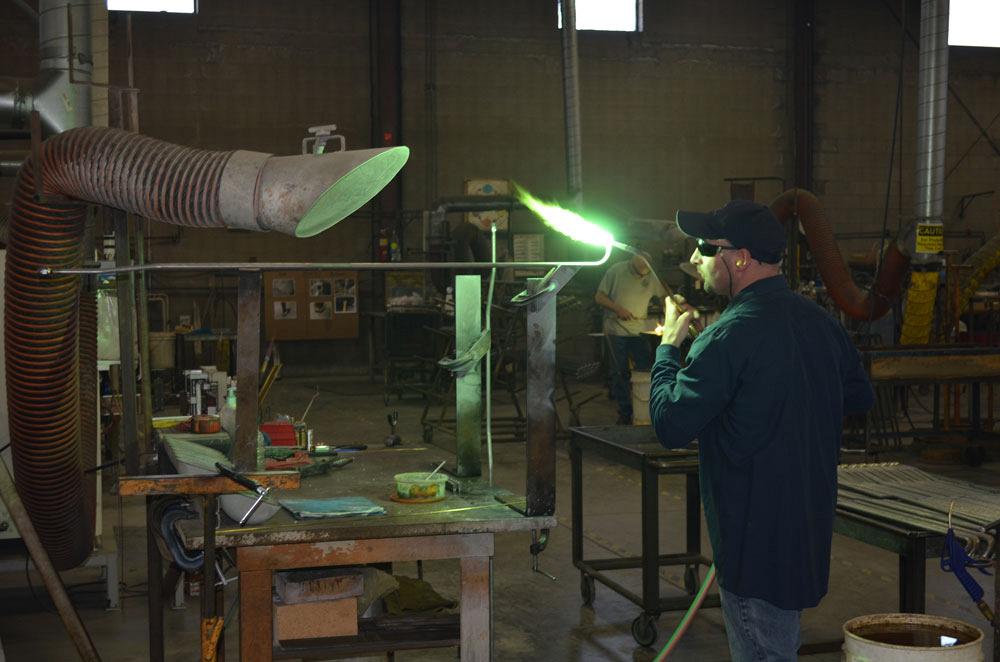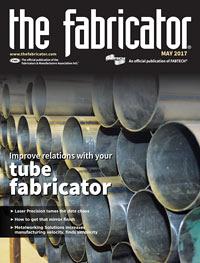Editor-in-Chief
- FMA
- The Fabricator
- FABTECH
- Canadian Metalworking
Categories
- Additive Manufacturing
- Aluminum Welding
- Arc Welding
- Assembly and Joining
- Automation and Robotics
- Bending and Forming
- Consumables
- Cutting and Weld Prep
- Electric Vehicles
- En Español
- Finishing
- Hydroforming
- Laser Cutting
- Laser Welding
- Machining
- Manufacturing Software
- Materials Handling
- Metals/Materials
- Oxyfuel Cutting
- Plasma Cutting
- Power Tools
- Punching and Other Holemaking
- Roll Forming
- Safety
- Sawing
- Shearing
- Shop Management
- Testing and Measuring
- Tube and Pipe Fabrication
- Tube and Pipe Production
- Waterjet Cutting
Industry Directory
Webcasts
Podcasts
FAB 40
Advertise
Subscribe
Account Login
Search
A guide to working with a tube fabricator
After almost 50 years in the tube business, J&D Tube Benders has some advice for purchasing agents and OEM engineers
- By Dan Davis
- April 27, 2017
- Article
- Tube and Pipe Fabrication
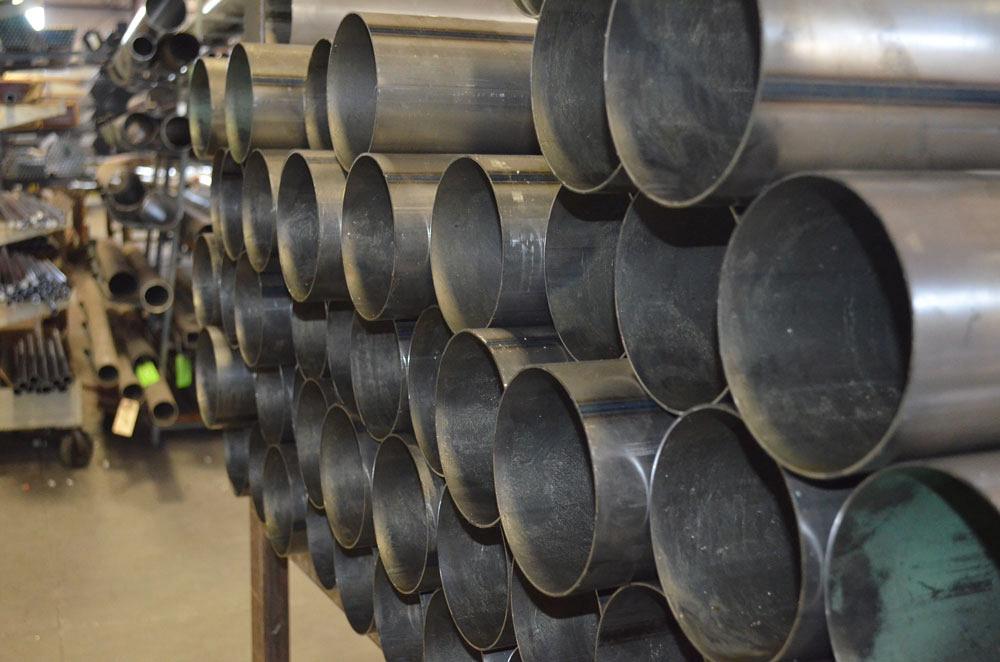
Figure 1
If a purchasing manager thinks keeping track of numerous part numbers for tube products is challenging, that same buyer might have a nervous breakdown thinking about the inventory that a tube fabricator keeps on hand to be responsive to customer demands.
Tom Felch, president, J&D Tube Benders Inc., in Schofield, Wis., has seen a lot of customer contacts move on during his tenure with the 46-year-old company. Engineers are a mobile lot these days because their skills are in demand. When an engineer familiar with J&D Tube’s fabricating capabilities moves to a new gig, sometimes the two parties reconnect, and a new relationship begins. Purchasing agents make similar moves, but in some instances, they may not be that keen on staying involved with tube products management. Simply put, such a task can be pretty exhausting because there can be a lot of part numbers.
Felch said that a manufacturer of heavy-duty construction equipment might have 2,000 part numbers for various tube products, from small-diameter hydraulic tubes to larger-diameter section tube that is used to hide hoses and other components. The part number corresponds to a tube product used in one particular construction assembly for one particular application.
“It’s easier to buy one mainframe section than it is to buy 100 different tube lines and control when they are going to be delivered,” Felch said.
With new faces involved in specifying fabricated tube products comes new challenges. In general, knowledge of tube bending is not widespread in the metal fabricating industry. Many look at it as a black art. That lack of tube knowledge becomes even more pronounced when those fresh faces managing the fabrication and delivery of tube parts and assemblies are doing it for the first time.
That’s why Felch said he was anxious to share some of his observations about working with an experienced tube fabrication shop (see Figure 1). If a buyer is more knowledgeable about what an experienced tube fabrication shop can bring to the table, both parties may be able to benefit from a more streamlined order and delivery process.
Here are six questions buyers should ask when looking to work with a tube fabricator.
1. Can you be flexible with the material?
When purchasers or engineers have to specify a material for tube bending but don’t have a lot of tube knowledge, they might look for any specification from another source—old or new. The old spec may not be current. The new spec may not be supported in a broad sense, making the material hard to source.
Felch described the scenario of a purchasing agent specifying a new SAE J (Society of Automotive Engineers-Japan) material that might not be widely available. Other tube stock of a different grade is available, and it can meet the pressure and formability requirements. It just doesn’t have the same number as originally requested.
Once the spec is on the blueprint, it can be hard to change in many circumstances. So now you have a newly introduced specialty material that is available from only one mill, which dramatically limits the supply base, a definite red flag for anyone involved in procurement.
“We battle this all the time,” Felch said. “When we can have that face-to-face conversation on that issue, we always succeed in the fact that we can show them all of the different materials. In most cases, it is going to meet or exceed what they are asking for.”
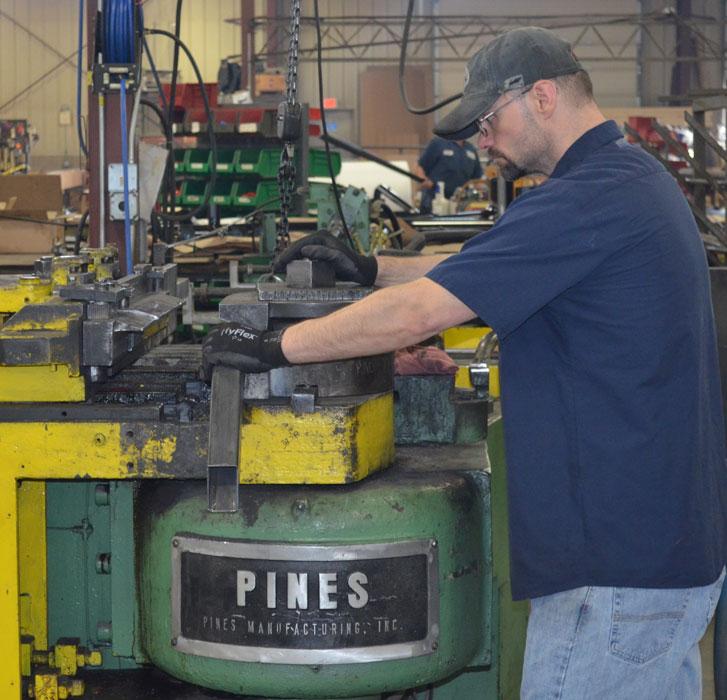
Figure 2
If given the flexibility to recommend material and design-for-manufacturability tips, an experienced tube bender can suggest the most efficient and cost-effective means to create a tube part.
2. Can you be flexible with the design?
Tube bending has limitations. Felch said they mostly have to do with leaving enough space between ends and bends. If inadequate space is specified on the drawing and there is no way to change the blueprint, a recut is going to be necessary as well as joining the two separate tube products. That recut means extra material handling, which adds time and cost to the overall job.
Many times these type of situations can be sidestepped if the customer is open to design-for-manufacturability suggestions (see Figure 2). For example, the old standard of two times diameter still is a pretty accurate guide to tube bending, Felch said. If you have a 2-in.-diameter tube, you need 4 in. from the ends before a bend can be made and at least 4 in. between subsequent bends in between.
“We could work with that,” Felch said.
Another obstacle is the actual diameter of the tube specified in the drawing. Just because a certain diameter is requested for a job doesn’t make it the right diameter for the job.
For instance, a purchaser may request a tube that calls for a 2.5-in. radius, but the tube fabricator may have bending tooling only for 2.25- or 2.75-in. radius, which also would fit and perform as prescribed in the blueprint design. However, the blueprint was very specific.
In this scenario, Felch said some customers just accept a tooling charge rather than try to make a change to the original design. That’s obviously an extra cost incurred, but it also adds time to the production cycle as the tooling has to be made, delivered, and tried out on the shop floor.
In the meantime, a tube with a slightly different diameter would have worked just as well.
“You can try and tell someone that I could bend 100 parts of both radii (2.5 and 2.75 in.), and he couldn’t sort them out. There is no way that you could see the difference from one radius to the next. They are that close,” he said.
3. Can you stick with industry standard componentry?
Just like material, a blueprint should call out an industry standard that is readily recognized by metal fabricators. This helps to keep project costs in line.
Again, just because an SAE standard exists doesn’t mean that it’s widely recognized. A fastener might meet the SAE standard, but it might have a thread configuration that is different from what the metal fabricator is accustomed to working with. That means a special order has to be made, and that takes time. Projects move along more smoothly when off-the-shelf components, which still meet required standards, are available to be ordered on a regular basis.

Figure 3
Tube fabricators are at the mercy of customers when it comes to quality programs. But can OEM customers show some mercy by making quality inspection less onerous and more manageable for small-scale projects?
4. Is your quality system doing you any favors?
Felch is quick to point out that any system that ensures quality of delivered parts is a good one (see Figure 3). A tube fabricator can choose whether or not to use quality systems, he said, but shops should understand that if they don’t, they are likely to lose the customer to another shop that will comply with expected quality programs.
Having said that, sometimes the quality control process can be streamlined without really threatening overall quality.
As an example, Felch brought up the production part approval process (PPAP) that emerged in the heavy construction industry after the Great Recession. Quality professionals from the automotive industry found jobs in this sector and brought their quality tools with them. The PPAP is meant to demonstrate that the part meets quality expectations and that the process used to make the part is repeatable and not at great risk of failure as production loads increase or as the part is revisited at a later date. These jobs are accompanied by PPAP packets that include design records, customer signoff, work procedure systems, and other documents that support proof of steps taken to ensure quality.
In the automotive industry, this quality approach is worth the effort. A part might be manufactured thousands of times to keep up with projected sales levels. The PPAP exercise for such a part is not seen as a big deal in light of the volume.
On the tube side, however, that effort can be overwhelming for a part that is ordered in much smaller volumes. Felch said they might spend two hours completing the PPAP for a part volume of five per year. Also, every time a revision is made to a design, another PPAP has to be created. If a part has not been purchased in a year, again, the PPAP has to be created.
“The end result is good, but I’m not sure it’s any better than when we were doing ISR [initial sample report] certifications and general compliance checks,” Felch said.
“Again, you aren’t going to supply parts that don’t meet your customer’s specifications.”
An OEM customer may not be too concerned about this burdensome type of quality effort, particularly if parts consistently meet expectations. However, if the OEM wants a financially healthy supply base, it might consider making changes to rigorous quality expectations, particularly as those labor hours on the supply side really aren’t a chargeable item.
5. Do you use advanced technology?
The presence of a laser tube cutting machine may not seem like a big deal to someone who has been in the metal fabrication industry for some time, but if he has been around for more than 15 years, he knows what it means to a shop (see Figure 4). Felch witnessed it back when J&D Tube purchased its first laser cutting machine in 2010. The bottleneck that existed in the machine shop disappeared as more tube work was directed to the new laser.
“Our secondary machining operations were cut by 40 percent overnight,” he said. “We used to have parts that needed to be cut, then bent, and then machined. Now we build a majority of those parts with the holes and the miter cuts in the laser cutting machine.”
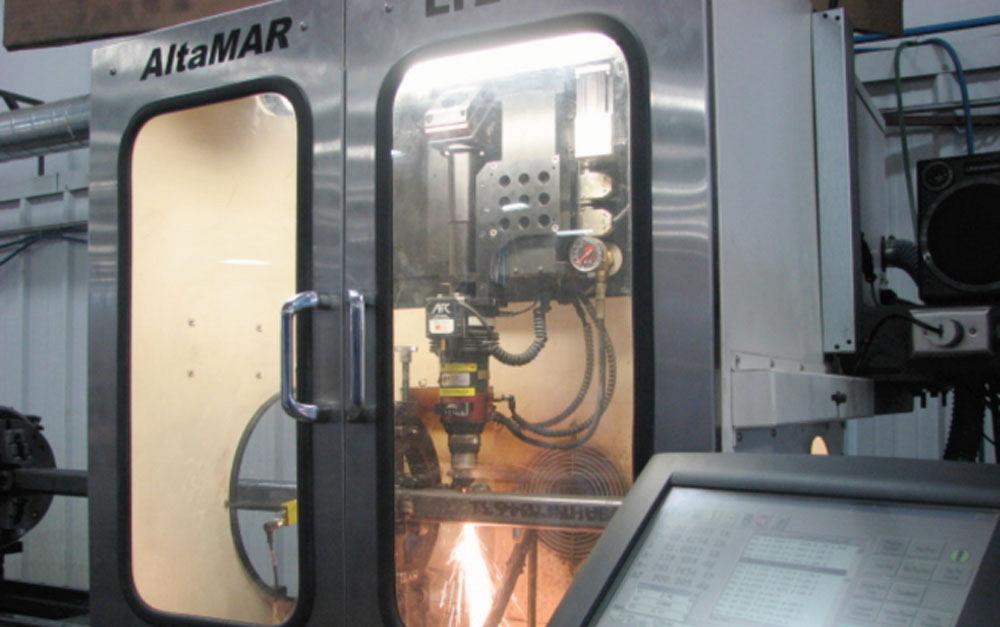
Figure 4
J&D Tube’s laser cutting machines eliminated the bottleneck in its machining department and enabled it to keep up with ever-shrinking turnaround times for jobs.
He added that plenty of those parts actually leave the laser and go right to shipping. The added time required for secondary processes and the increased risk of quality mishaps that accompany excessive material handling in a manufacturing environment no longer exist for the parts coming off the laser cutting machine. Some tube products still are destined for the machine shop, such as when a hole needs to be drilled near a tangent, but they now can be processed quickly to meet lead-time expectations of 12 to 15 working days.
Robotic welding cells also are becoming a more common sight on shop floors. Felch said that his company’s two cells have increased productivity dramatically in the welding area as labor has been freed up for other areas. One robotic cell’s output equals the output of at least three full-time brazers of tube products (see Figure 5), and the other cell, with its three stations, can churn out completed parts with multiple welds on a 60-second cycle. Felch said this type of production efficiency allows them to maintain lead-time commitments and accommodate rush jobs when they are needed.
6. How do you handle shipping?
Most tube parts and assemblies don’t organize easily. It’s not like a sheet metal part that sits nicely on top of another.
So that leaves a good question: How are they to be delivered? Are multiple parts in one container OK? Can they be packed with other parts destined for the same place? Is the use of returnable containers an option (see Figure 6)?
As with any aspect of the design-to-delivery cycle, a cost can be assigned to shipping. It helps to be clear and understand options to minimize waste.
Felch said that asking these questions prior to engaging a tube fabricator helps the OEM-supplier relationship get off to a good start. Most tube fabricators work with the same material and employ the same bending, cutting, and machining technology, so service is the real differentiator in these relationships. Giving a tube fabricator enough room to recommend cost-effective materials and design-for-manufacturability tips, as well as understanding what this flexibility means in terms of lead times and project costs, puts all parties in a position to reap the benefits of a strong supply chain relationship.
J&D Tube Benders Inc., 800-283-8302, www.jdtube.com
dAbout the Author

Dan Davis
2135 Point Blvd.
Elgin, IL 60123
815-227-8281
Dan Davis is editor-in-chief of The Fabricator, the industry's most widely circulated metal fabricating magazine, and its sister publications, The Tube & Pipe Journal and The Welder. He has been with the publications since April 2002.
Related Companies
subscribe now

The Fabricator is North America's leading magazine for the metal forming and fabricating industry. The magazine delivers the news, technical articles, and case histories that enable fabricators to do their jobs more efficiently. The Fabricator has served the industry since 1970.
start your free subscription- Stay connected from anywhere

Easily access valuable industry resources now with full access to the digital edition of The Fabricator.

Easily access valuable industry resources now with full access to the digital edition of The Welder.

Easily access valuable industry resources now with full access to the digital edition of The Tube and Pipe Journal.
- Podcasting
- Podcast:
- The Fabricator Podcast
- Published:
- 04/16/2024
- Running Time:
- 63:29
In this episode of The Fabricator Podcast, Caleb Chamberlain, co-founder and CEO of OSH Cut, discusses his company’s...
- Trending Articles
Tips for creating sheet metal tubes with perforations

JM Steel triples capacity for solar energy projects at Pennsylvania facility

Are two heads better than one in fiber laser cutting?

Supporting the metal fabricating industry through FMA

Omco Solar opens second Alabama manufacturing facility

- Industry Events
16th Annual Safety Conference
- April 30 - May 1, 2024
- Elgin,
Pipe and Tube Conference
- May 21 - 22, 2024
- Omaha, NE
World-Class Roll Forming Workshop
- June 5 - 6, 2024
- Louisville, KY
Advanced Laser Application Workshop
- June 25 - 27, 2024
- Novi, MI
























